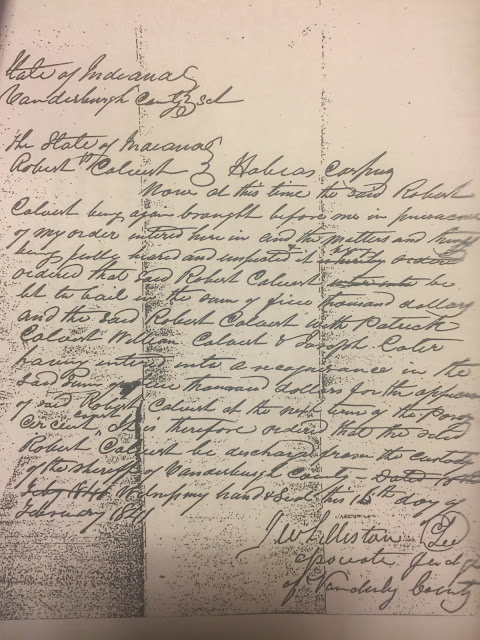A Vicious Crime Destroys a Family: The Murder of Lydia Smith Calvert
Lydia Jane Smith Calvert: 1807-1840 (Maternal First Cousin 4x Removed)
Late in June of 1840, George Rudolphus Smith (Third Great
Granduncle) was near death. He was almost seventy years old—not a great age,
but he may have been feeling ill for some time since he had made his will some
months previously. He was confident that his children would be provided for
once he had died. One of the heirs named in his will was his daughter Lydia.
George probably had no idea that Lydia, a mother of five who was only 33 years
old, would be murdered by her own husband just weeks after George’s death. Not
only were her five little children suddenly left without their mother, but they
also lost their maternal grandfather, and their paternal grandmother, who died right
after Lydia did. And they also lost their father after he was indicted for
Lydia’s murder.
So what led up to this tragedy? Lydia Jane Smith was born January
6, 1807, the fourth child of George Rudolphus Smith and his first wife Lydia
“Jenney” Tait Smith. Lydia’s life began with tragedy as well—her mother died
giving birth to her. George R Smith remarried three years later, and little
Lydia soon had eight half siblings.
Lydia married Robert Patrick Calvert on May 3, 1827. They
were both twenty years old. Robert had a farm in Posey County, Indiana where
they lived. Their first child, Eudoxy, (also known as Emily) was born in 1829.
Two little boys, Patrick and George, were born in 1830 and 1832. Daughter
Elizabeth was born in 1835, and their final son, Jordan, was born in 1838.
Lydia’s death was brutal. A descendant has posted the
handwritten murder indictment the Posey County Grand Jury brought against
Robert. The indictment stated that on August 10, 1840, Robert Calvert:
“with force and onus
in and upon one Lydia Cavett wife of said Robert Cavett feloniously, willfully
and with malice aforethought did make an assault and that said Robert Cavett
then and there felonious, willfully and of his malice aforethought did strike,
beat and kick the said Lydia Cavett with his hands and feet in an upon the
belly, breast, sides and other parts of the body of the said Lydia Cavett and
did then and therefore feloniously willfully and his malice aforethought cast
and threw the said Lydia Cavett down with great force and violence…”
This attack caused “several
mortal strokes wounds and bruises in and upon the belly, breast, sides and other
parts of the body of her said Lydia Cavett to wit one mortal bruise and wound
on the belly of her the said Lydia Cavett between the left nipple and navel…”
.jpg)
First page of Grand Jury Indictment
It took her a day to die of her injuries. I have to guess
that at least some of Lydia’s children witnessed the assault, as the details
about him kicking her and throwing her forcefully onto the ground sound like
eye-witness testimony. Given the brutality, it is likely that this attack was
but one of many she suffered over their thirteen years of marriage. Men
generally don’t commit murder the first time they beat their wives. He seems to
have been a violent person from childhood, as another descendant posted a story
about young Robert attacking a child his father was caring for with an axe, cutting
off the boy’s foot. I shudder to think of the horrors Lydia suffered over those
long years, and the terror her children experienced.
Calvert was arrested in August of 1840 and was fortunate that his father, Patrick Calvert, chose to post the huge sum of $5000 bond to get him released.
 |
| Father Patrick Calvert puts up bond for son |
Robert came to trial in March of 1841. Despite the Grand Jury
report and the efforts of the prosecutor,
“twelve good and
lawful men who being elected tried and sworn upon their oaths do say ‘We the
Jury find the Defendant not guilty.”
Of course the jury was composed only of men, since women had
no rights in the 1840s. Apparently those supposedly good and lawful men
believed Robert Calvert was perfectly justified to beat his wife to death.
Luckily for Lydia’s five traumatized children, they were not
sent to live with their father, the murderer. Instead, Robert’s father Patrick
took them in and raised them. Robert seems to have disappeared from records
following his acquittal. I believe he left Posey County and may have died in the
1850s, but I have no records to verify this.
Robert’s father Patrick died in 1861. Four of Lydia’s
children—Eudoxy, Patrick, Elizabeth and Jordan survived at that time and were
beneficiaries in Patrick’s will, each receiving $244.57. The remaining child,
George, died at age 23 in 1855, and was buried near his grandfather Patrick on
Patrick Calvert’s farm. I will write about George and Patrick’s graves in a
future post.
 |
| Section of Patrick Calvert's will dealing with Lydia's surviving children |
As for poor Lydia, she was laid to rest in the Smith
Cemetery in Posey County where her parents and other relatives are buried.
Sadly, the cemetery is on private property and is inaccessible. Her grave is
unmarked.
 |
| Smith Cemetery in Posey County--courtesy of Findagrave |
Lydia never received justice. Her killer, her own husband
who had taken--and broken--vows to protect and honor her, went free despite strong
evidence that he beat her to death. She deserves to have candles lit in her
memory, and to have prayers offered up that she can somehow rest in peace.
Sources:
Posey County documents posted on Ancestry.com.
.jpg)




No comments:
Post a Comment